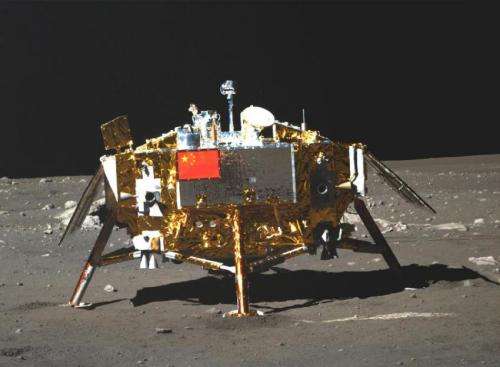March 13, 2015 report
China's Yutu lunar rover finds moon geography more complex than thought

(Phys.org)—A team of researchers working on China's Chang'E-3 lunar mission has found multiple distinct geographic rock layers beneath the surface of the moon, indicating a much more complex geographical history than was previously thought by most in the scientific community. In their paper published in the journal Science, the team describes their analysis of data sent back by the Yutu rover.
On December 14, 2013, China's China's Chang'E-3 spacecraft touched down on the surface of the moon, the first to conduct a soft landing since the Soviet Union sent craft back in 1976. A few hours after landing, a rover named Yutu (Jade Rabbit) was released from the craft and set off on a zig-zag course across the nearby terrain. Onboard the rover was a variety of sensor equipment, one of which offered Lunar Penetrating Radar (LPR) capable of probing up to 400 meters below the lunar surface. The rover captured subsurface data for approximately a month before technical problems caused it to shut down.
In this new report, the researchers studying the data sent back by the rover report that LPR revealed nine distinct rock layers beneath the surface, indicating a geographical history far more complex than has been theorized. The layering is due, apparently, to lava flows which were mixed with regolith (lunar dust formed by weathering). The data sent back from Yutu is the first to reveal deep subsurface details—during the Apollo missions, drills were used to gather samples of subsurface rock, but they only penetrated to a depth of three meters.
The team notes that in studying the rock layers, they made two important finds, the first was that the evidence shows that the moon has had far more volcanic activity than has been thought and the second was that the area under study showed that in addition to basalt there was pyroclastic rocks, an indication of explosive activity. Most who have studied the moon have believed that volatile gasses trapped in the mantle escaped while the moon was still forming. This new evidence suggests that was not the case.
The team also notes that the composition of the geography where Yutu was operating appeared to be quite different from that observed by the U.S.'s Apollo missions and the U.S.S.R.'s Luna missions.
More information: A young multilayered terrane of the northern Mare Imbrium revealed by Chang'E-3 mission, Science 13 March 2015: Vol. 347 no. 6227 pp. 1226-1229 . DOI: 10.1126/science.1259866
Abstract
China's Chang'E-3 (CE-3) spacecraft touched down on the northern Mare Imbrium of the lunar nearside (340.49°E, 44.12°N), a region not directly sampled before. We report preliminary results with data from the CE-3 lander descent camera and from the Yutu rover's camera and penetrating radar. After the landing at a young 450-meter crater rim, the Yutu rover drove 114 meters on the ejecta blanket and photographed the rough surface and the excavated boulders. The boulder contains a substantial amount of crystals, which are most likely plagioclase and/or other mafic silicate mineral aggregates similar to terrestrial dolerite. The Lunar Penetrating Radar detection and integrated geological interpretation have identified more than nine subsurface layers, suggesting that this region has experienced complex geological processes since the Imbrian and is compositionally distinct from the Apollo and Luna landing sites.
Journal information: Science
© 2015 Phys.org



















